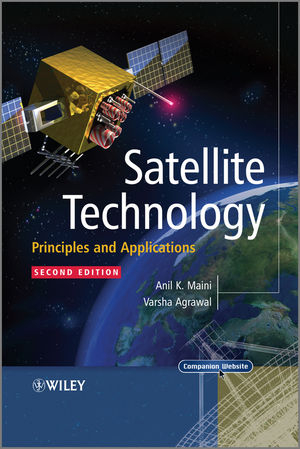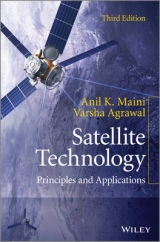
Satellite Technology
Wiley-Blackwell (Verlag)
978-0-470-66024-9 (ISBN)
- Titel erscheint in neuer Auflage
- Artikel merken
Fully updated new edition with latest technological developments Covers the full range of important applications such remote sensing, weather forecasting, navigational, scientific and military applications Amply illustrated with figures and photographs, this book also contains problems with solutions, which is of benefit students at undergraduate and graduate levels An indispensible book for professionals and students in the field of satellite technology Companion website provides a complete and updated compendium on satellites and satellite launch vehicles
SH. ANIL K. MAINI is Director at the Laser Science and Technology Centre (LASTEC), an R&D establishment under the Defence Research and Development Organization (DRDO), India. He has more than 30 years of research experience in a wide range of defence electronics, optoelectronics and laser systems. His areas of expertise include optoelectronic sensor systems, laser systems, power electronics, digital electronics and related technologies. At LASTEC, he is spearheading the development of laser systems and optoelectronics simulators and sensors. He has written eleven books, around 150 publications and has two patents to his credit. He is life fellow of The Institution of Electronics and Telecommunication Engineers (IETE) and a life member of The Indian Laser Association. VARSHA AGRAWAL is a scientist at the Laser Science and Technology Centre (LASTEC), an R&D establishment under the Defence Research and Development Organization (DRDO), India. She has been with DRDO for the last ten years and has been working on the design and development of a variety of electronics subsystems for various defence-related applications. She has three written books: Satellite Technology: Principles and Applications, Satellite Communications and Electronics Devices and Circuits.
Table of Contents PART I SATELLITE TECHNOLOGY 1 1 Introduction to Satellites and Their Applications 1.1 Ever-expanding Application Spectrum 1.2 What is a Satellite? 1.3 History of the Evolution of Satellites 1.4 Evolution of Launch Vehicles 1.5 Future Trends Further Reading Glossary 2 Satellite Orbits and Trajectories 2.1 Definition of an Orbit and a Trajectory 2.2 Orbiting Satellites - Basic Principles 2.3 Orbital Parameters 2.4 Injection Velocity and Resulting Satellite Trajectories 2.5 Types of Satellite Orbits Further Reading Glossary 3 Satellite Launch and In-Orbit Operations 3.1 Acquiring the Desired Orbit 3.2 Launch Sequence 3.3 Orbital Perturbations 3.4 Satellite Stabilization 3.5 Orbital Effects on Satellite's Performance 3.6 Eclipses 3.7 Look Angles of a Satellite 3.8 Earth Coverage and Ground Tracks Further Reading Glossary 4 Satellite Hardware 4.1 Satellite Subsystems 4.2 Mechanical Structure 4.3 Propulsion Subsystem 4.4 Thermal Control Subsystem 4.5 Power Supply Subsystem 4.6 Attitude and Orbit Control 4.6.1 Attitude Control 4.6.2 Orbit Control 4.7 Tracking, Telemetry and Command Subsystem 4.8 Payload 4.9 Antenna Subsystem 4.10 Space Qualification and Equipment Reliability Further Reading Glossary 5 Communication Techniques 5.1 Types of Information Signals 5.2 Amplitude Modulation 5.3 Frequency Modulation 5.4 Pulse Communication Systems 5.5 Sampling Theorem 5.6 Shannon-Hartley Theorem 5.7 Digital Modulation Techniques 5.8 Multiplexing Techniques Further Reading Glossary 6 Multiple Access Techniques 6.1 Introduction to Multiple Access Techniques 6.2 Frequency Division Multiple Access (FDMA) 6.3 Single Channel per Carrier (SCPC) Systems 6.4 Multiple Channels Per Carrier (MCPC) Systems 6.5 Time Division Multiple Access (TDMA) 6.6 TDMA Frame Structure 6.7 TDMA Burst Structure 6.8 Computing Unique Word Detection Probability 6.9 TDMA Frame Efficiency 6.10 Control and Coordination of Traffic 6.11 Frame Acquisition and Synchronization 6.12 FDMA vs. TDMA 6.13 Code Division Multiple Access (CDMA) 6.14 Space Division Multiple Access (SDMA) Further Reading Glossary 7 Satellite Link Design Fundamentals 7.1 Transmission Equation 7.2 Satellite Link Parameters 7.3 Frequency Considerations 7.4 Propagation Considerations 7.5 Techniques to Counter Propagation Effects 7.6 Noise Considerations 7.7 Interference-related Problems 7.8 Antenna Gain-to-noise Temperature (G/T) Ratio 7.9 Link Design Further Reading Glossary 8 Earth Station Earth Station Types of Earth Stations Earth Station Architecture Earth Station Design Considerations Earth Station Testing Earth Station Hardware Satellite Tracking Some Representative Earth Stations Further Reading Glossary PART II SATELLITE APPLICATIONS 9 Communication Satellites 9.1 Introduction to Communication Satellites 9.2 Communication-Related Applications of Satellites 9.3 Frequency Bands 9.4 Payloads 9.5 Satellite versus Terrestrial Networks 9.6 Satellite Telephony 9.7 Satellite Television 9.8 Satellite Radio 9.9 Satellite Data Communication Services 9.10 Important Missions 9.11 Future Trends Further Reading Glossary 10 Remote Sensing Satellites 10.1 Remote Sensing - An Overview 10.2 Classification of Satellite Remote Sensing Systems 10.3 Remote Sensing Satellite Orbits 10.4 Remote Sensing Satellite Payloads 10.5 Passive Sensors 10.6 Active Sensors 10.7 Types of Images 10.8 Image Classification 10.9 Image Interpretation 10.10 Applications of Remote Sensing Satellites 10.11 Major Remote Sensing Missions 10.12 Future Trends Further Reading Glossary 11 Weather Satellites 11.1 Weather Forecasting - An Overview 11.2 Weather Forecasting Satellite Fundamentals 11.3 Images from Weather Forecasting Satellites 11.4 Weather Forecasting Satellite Orbits 11.5 Weather Forecasting Satellite Payloads 11.6 Image Processing and Analysis 11.7 Weather Forecasting Satellite Applications 11.8 Major Weather Forecasting Satellite Missions 11.9 Future of Weather Forecasting Satellite Systems Further Reading Glossary 12 Navigation Satellites 12.1 Development of Satellite Navigation Systems 12.2 Global Positioning System (GPS) 12.3 Working Principle of the GPS 12.4 GPS Positioning Services and Positioning Modes 12.5 GPS Error Sources 12.6 GLONASS Satellite System 12.7 GPS-GLONASS Integration 12.8 Applications of Satellite Navigation Systems 12.9 Future of Satellite Navigation Systems Further Reading Glossary 13 Scientific Satellites 13.1 Satellite-Based versus Ground-Based Scientific Techniques 13.2 Payloads on Board Scientific Satellites 13.3 Applications of Scientific Satellites - Study of Earth 13.4 Observation of the Earth's Environment 13.5 Astronomical Observations 13.6 Missions for Studying Planets of the Solar System 13.7 Missions Beyond the Solar System 13.8 Other Fields of Investigation 13.9 Future Trends Further Reading Glossary 14 Military Satellites 14.1 Military Satellites - An Overview 14.2 Satellite Military Communication 14.3 Development of Military Communication Satellite Systems 14.4 Frequency Spectrum Utilized by Military Communication Satellite Systems 14.5 Dual-use Military Satellite Communication Satellite Systems 14.6 Reconnaissance Satellites 14.7 SIGINT Satellites 14.8 Early Warning Satellites 14.9 Nuclear Explosion Satellites 14.10 Military Weather Forecasting Satellites 14.11 Military Navigation Satellites 14.12 Space Weapons 14.13 Strategic Defence Initiative 14.14 Directed Energy Laser Weapons 14.15 Advanced Concepts Further Reading Glossary Subj ect Index
| Erscheint lt. Verlag | 1.11.2010 |
|---|---|
| Zusatzinfo | Illustrations |
| Verlagsort | Hoboken |
| Sprache | englisch |
| Maße | 170 x 247 mm |
| Gewicht | 1272 g |
| Einbandart | gebunden |
| Themenwelt | Technik ► Elektrotechnik / Energietechnik |
| Technik ► Nachrichtentechnik | |
| ISBN-10 | 0-470-66024-4 / 0470660244 |
| ISBN-13 | 978-0-470-66024-9 / 9780470660249 |
| Zustand | Neuware |
| Informationen gemäß Produktsicherheitsverordnung (GPSR) | |
| Haben Sie eine Frage zum Produkt? |
aus dem Bereich



